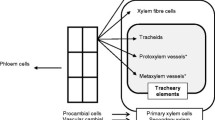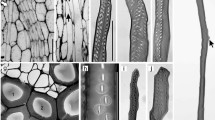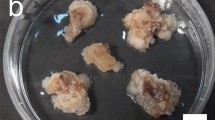Abstract
Secondary growth is a highly relevant process for dicot and gymnosperm species development. The process relies on vascular tissue proliferation and culminates with the thickening of stems, roots, and hypocotyls. The formation of tracheary elements is a critical step during this process. Among such tracheary elements, four different cell types are distinguished depending on their secondary cell wall pattern, which is exclusive for each tracheary cell type. Here we describe a method to isolate, dye, and recognize each of these tracheary cell types. The method is optimized to be performed in the Arabidopsis thaliana hypocotyl. This is because, in this species, the hypocotyl is the organ undergoing the largest proportion of secondary growth. Results allow for determining the relative amounts of each of the tracheary cell types.
Access this chapter
Tax calculation will be finalised at checkout
Purchases are for personal use only
Similar content being viewed by others
References
Fukuda H (2004) Signals that control plant vascular cell differentiation. Nat Rev Mol Cell Biol 5:379–391
Ko JH, Han KH, Park S et al (2004) Plant body weight-induced secondary growth in Arabidopsis and its transcription phenotype revealed by whole-transcriptome profiling. Plant Physiol 135:1069–1083
Sibout R, Plantegenet S, Hardtke CS (2008) Flowering as a condition for xylem expansion in Arabidopsis hypocotyl and root. Curr Biol 18:458–463
Chaffey N, Cholewa E, Regan S et al (2002) Secondary xylem development in Arabidopsis: a model for wood formation. Physiol Plant 114:594–600
Mark RE (1967) Cell wall mechanics of tracheids. Yale University Press, New Haven
Roberts AW, Frost AO, Roberts EM et al (2004) Roles of microtubules and cellulose microfibril assembly in the localization of secondary-cell-wall deposition in developing tracheary elements. Protoplasma 224:217–229
Pesquet E, Korolev AV, Calder G et al (2010) The microtubule-associated protein AtMAP70-5 regulates secondary wall patterning in Arabidopsis wood cells. Curr Biol 20:744–749
Esau K (1977) Anatomy of the seed plants, 2nd edn. Wiley, New York
Karam GN (2005) Biomechanical model of the xylem vessels in vascular plants. Ann Bot 95:1179–1186
Turner S, Gallois P, Brown D (2007) Tracheary element differentiation. Annu Rev Plant Biol 58:407–433
Evans WC (2009) Trease and Evans Pharmacognosy, 16th edn. Elsevier Inc., Edinburgh
Muñiz L, Minguet EG, Singh SK et al (2008) ACAULIS5 controls Arabidopsis xylem specification through the prevention of premature cell death. Development 135:2573–2582
Franklin GL (1945) Preparation of thin sections of synthetic resins and wood resin composites, and a new macerating method for wood. Nature 155:51
Author information
Authors and Affiliations
Corresponding author
Editor information
Editors and Affiliations
Rights and permissions
Copyright information
© 2024 The Author(s), under exclusive license to Springer Science+Business Media, LLC, part of Springer Nature
About this protocol
Cite this protocol
Brunot-Garau, P., Úrbez, C., Vera-Sirera, F. (2024). Quantification of Tracheary Elements Types in Mature Hypocotyl of Arabidopsis thaliana. In: Agusti, J. (eds) Xylem. Methods in Molecular Biology, vol 2722. Humana, New York, NY. https://doi.org/10.1007/978-1-0716-3477-6_10
Download citation
DOI: https://doi.org/10.1007/978-1-0716-3477-6_10
Published:
Publisher Name: Humana, New York, NY
Print ISBN: 978-1-0716-3476-9
Online ISBN: 978-1-0716-3477-6
eBook Packages: Springer Protocols




